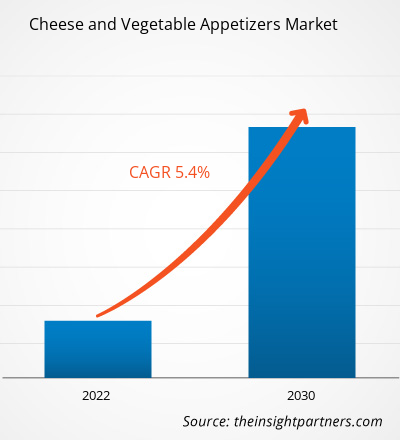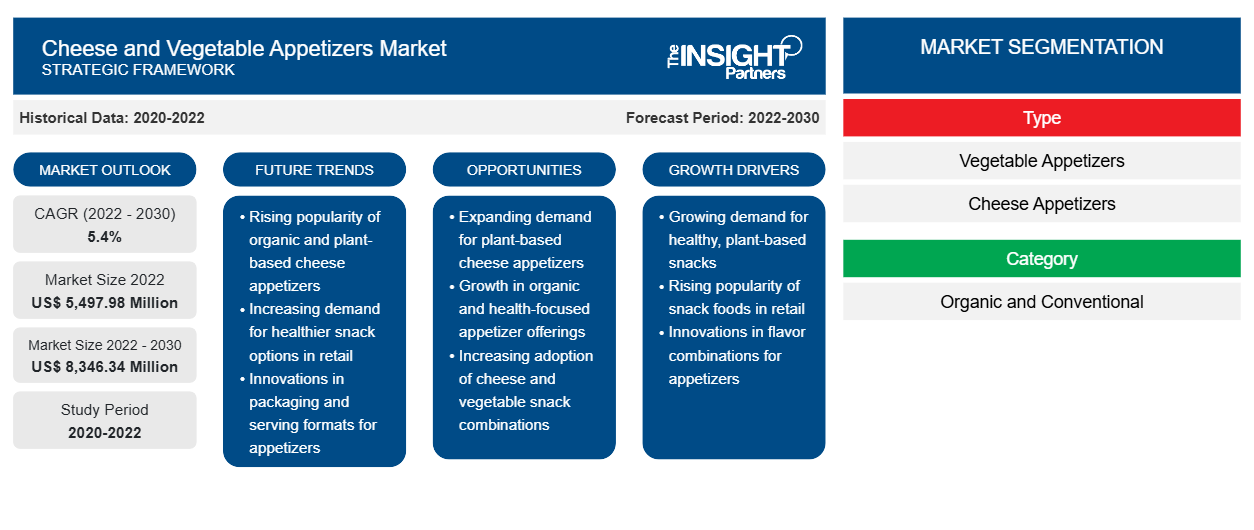[Forschungsbericht] Der Markt für Käse- und Gemüsehäppchen soll von 5.497,98 Millionen US-Dollar im Jahr 2022 auf 8.346,34 Millionen US-Dollar im Jahr 2030 wachsen; von 2022 bis 2030 wird eine durchschnittliche jährliche Wachstumsrate (CAGR) von 5,4 % erwartet .
Markteinblicke und Analystenansichten:
In den letzten Jahren hat sich der Lebensstil der Verbraucher dramatisch verändert. Verbraucher verbringen die meiste Zeit in Büros und am Arbeitsplatz. Aus Zeitmangel bevorzugen sie Fertiggerichte und Instant-Lebensmittel, die nur minimalen Zeit- und Arbeitsaufwand erfordern. Dieser Faktor treibt das globale Wachstum des Marktes für Käse- und Gemüsehäppchen voran . Auch das steigende Bewusstsein der jüngeren Bevölkerung für die Vorteile von Käse als gute Protein- und Kalziumquelle und die breite Verfügbarkeit einer Vielzahl von Käse- und Gemüsehäppchen fördern das Marktwachstum.
Aufgrund des modernen Lebensstils, der von vollen Terminkalendern und einer Vorliebe für schnelle und tragbare Nahrungsmittel geprägt ist, suchen Verbraucher nach leicht zu verzehrenden und schmackhaften Tiefkühl-Häppchen. Tiefgekühlte Käse- und Gemüse-Häppchen sind leicht zuzubereiten und erfüllen diese Nachfrage perfekt. Durch ihre Vorverpackung können Verbraucher einen köstlichen und gesunden Snack ohne aufwändige Zubereitung genießen, der sich nahtlos in das schnelle, moderne Leben einfügt.
Darüber hinaus spiegelt der Aufstieg von Fertiggerichten eine Veränderung im Verbraucherverhalten wider, bei der traditionelle Mahlzeitenstrukturen häufigen, kleineren Mahlzeiten weichen. Gefrorene Käse- und Gemüsehäppchen, die für den Transport und den einfachen Verzehr konzipiert sind, sind ideal für Personen, die ihren Hunger zwischen den Hauptmahlzeiten stillen möchten. Die einfache Zubereitung dieser Snacks ist eine praktische Lösung, wenn Verbraucher unterwegs einen schnellen Energieschub oder eine leckere Kleinigkeit brauchen. Verpackungsinnovationen im Markt für Käse- und Gemüsehäppchen wie Einzelportionspackungen, wiederverschließbare Behälter und portionierbare Optionen erhöhen den Komfort dieser Snacks.
Wachstumstreiber und Herausforderungen:
Die zunehmende Verwendung von gefrorenen Käse- und Gemüsehäppchen in der Gastronomie ist auf die wachsende Nachfrage nach gesünderen Snacks zurückzuführen, aber auch auf die praktische Möglichkeit, Kunden schnell mit diesen Produkten zu bedienen. Restaurants und Catering-Services nehmen immer häufiger eine vielfältige Auswahl an gefrorenen Gemüsehäppchen in ihre Menüs auf, um den Vorlieben gesundheitsbewusster und vegetarischer Verbraucher gerecht zu werden. Der Trend wird durch eine Verschiebung hin zu bewussteren Essgewohnheiten und den Wunsch nach ausgewogenen, nahrhaften Alternativen vorangetrieben. Auf dem globalen Markt für Käsehäppchen gibt es einen deutlichen Anstieg der Beliebtheit von Häppchen, der von den reichen kulinarischen Traditionen der Region angetrieben wird. Sowohl traditionelle als auch moderne gefrorene Käsehäppchen gewinnen in der Gastronomie an Bedeutung.
Die Verwendung verschiedener Käsesorten, darunter auch lokale Spezialitäten, verleiht dem Angebot an gefrorenen Vorspeisen eine einzigartige und genussvolle Dimension. Da der Foodservice-Sektor weiter wächst und sich diversifiziert, tragen gefrorene Käsevorspeisen zu einer anspruchsvollen und global beeinflussten kulinarischen Landschaft bei. In Europa rückt der Fokus auf gefrorene Käsevorspeisen, und der Markt erlebt aufgrund der zeitlosen Attraktivität von Snacks auf gefrorener Käsebasis einen bemerkenswerten Aufschwung. Europäische Verbraucher schätzen die Vielseitigkeit von Käse, und Gastronomiebetriebe nutzen dies, indem sie eine Vielzahl innovativer gefrorener Käsevorspeisen einführen. Von klassischen Käseplatten bis hin zu modernen Varianten wie mit Käse gefülltem Gebäck und Häppchen sind die Optionen vielfältig und richten sich an unterschiedliche Geschmäcker und Vorlieben. Die steigende Beliebtheit gefrorener Käsevorspeisen spiegelt die anhaltende Liebe zu käsebasierten Köstlichkeiten und die kontinuierliche Erforschung neuer kulinarischer Erfahrungen wider. Die Nachfrage nach Gemüsevorspeisen wächst aufgrund des zunehmenden Bewusstseins für die gesundheitlichen Vorteile einer Bio-Ernährung. Die Nahrungsmittelindustrie in der Region reagiert auf diesen Trend, indem sie eine große Auswahl an Vorspeisen aus tiefgekühltem Gemüse anbietet, die lokale und international inspirierte Aromen zur Schau stellen.
Herausforderungen in der Lieferkette können sich jedoch negativ auf die Produktion, den Vertrieb und die Verfügbarkeit von Produkten auswirken. Eine der größten Herausforderungen ergibt sich aus der Saisonalität vieler Gemüsesorten, die in Tiefkühlgemüse-Häppchen verwendet werden. Schwankungen bei den Wetterbedingungen und der landwirtschaftlichen Produktion können zu Unsicherheiten bei der Verfügbarkeit und Qualität frischer Produkte führen, was sich direkt auf den Herstellungsprozess auswirkt. Die Abhängigkeit von saisonalen Zutaten macht es für die Produzenten schwierig, das ganze Jahr über eine konsistente und zuverlässige Lieferkette aufrechtzuerhalten, was möglicherweise zu Engpässen und Störungen führt.
Faktoren wie Milchproduktionszyklen, Schwankungen in der Milchqualität und logistische Probleme beim Transport von Milchprodukten können die Lieferkette von Käse stören. Die Verderblichkeit von Milchprodukten macht die Lieferkette zusätzlich komplexer, da die Erhaltung der Frische während des Transports und der Lagerung von entscheidender Bedeutung ist.
Passen Sie diesen Bericht Ihren Anforderungen an
Sie erhalten kostenlose Anpassungen an jedem Bericht, einschließlich Teilen dieses Berichts oder einer Analyse auf Länderebene, eines Excel-Datenpakets sowie tolle Angebote und Rabatte für Start-ups und Universitäten.
-
Holen Sie sich die wichtigsten Markttrends aus diesem Bericht.Dieses KOSTENLOSE Beispiel umfasst eine Datenanalyse von Markttrends bis hin zu Schätzungen und Prognosen.
Berichtssegmentierung und -umfang:
Der „Globale Markt für Käse- und Gemüsehäppchen“ ist nach Typ, Kategorie, Endverbraucher und Geografie segmentiert. Nach Typ wird der Markt in Gemüsehäppchen und Käsehäppchen unterteilt. Nach Kategorie wird der Markt in Bio und Konventionell unterteilt. Nach Endverbraucher wird der Markt in Gastronomie und Lebensmitteleinzelhandel segmentiert. Nach Geografie wird der Markt in Nordamerika, Europa, Asien-Pazifik, Naher Osten und Afrika sowie Süd- und Mittelamerika kategorisiert.
Segmentanalyse:
Je nach Typ ist der Markt in Gemüse-Vorspeisen und Käse-Vorspeisen unterteilt. Das Segment der Gemüse-Vorspeisen hatte im Jahr 2022 einen größeren Anteil am globalen Markt für Käse- und Gemüse-Vorspeisen. Gemüse-Vorspeisen sind kulinarische Kreationen, bei denen es darauf ankommt, eine Vielzahl von Gemüsesorten als Hauptzutaten zu verwenden, um verlockende und schmackhafte Vorspeisen zuzubereiten. Der Anstieg der Nachfrage nach Gemüse-Vorspeisen kann auf mehrere Faktoren zurückgeführt werden, wie etwa die zunehmende Betonung einer gesünderen Lebensmittelauswahl und das steigende Bewusstsein für pflanzliche Ernährung. Da immer mehr Menschen einen vegetarischen oder flexitarischen Lebensstil annehmen, besteht ein erhöhtes Interesse an Vorspeisen, die den Ernährungsvorlieben entsprechen und die Vielseitigkeit und Köstlichkeit von Gemüse zur Geltung bringen. Darüber hinaus spiegelt die Nachfrage einen breiteren kulinarischen Trend wider, bei dem Verbraucher nach innovativen und vielfältigen Optionen suchen, was Köche und Lebensmittelproduzenten dazu veranlasst, gemüsezentrierte Vorspeisen herzustellen, die den Gaumen verwöhnen und zu einem kulinarischen Erlebnis beitragen, das auf pflanzliche und nachhaltige Lebensmittel ausgerichtet ist.
Regionale Analyse:
Der globale Markt für Käse- und Gemüsehäppchen ist in fünf Schlüsselregionen unterteilt: Nordamerika, Europa, Asien-Pazifik, Naher Osten und Afrika sowie Süd- und Mittelamerika. Der Markt wurde von Europa dominiert und machte im Jahr 2022 ca. 1.503 Millionen US-Dollar aus. Die steigende Nachfrage nach pflanzlichen Lebensmitteln und die Verfügbarkeit einer vielfältigen Palette an Gemüse- und Käsehäppchen treiben das Wachstum des Marktes für Käse- und Gemüsehäppchen in Europa voran. In den letzten Jahren haben sich pflanzliche Lebensmittel in der Region von einem Nischenprodukt zu einem Mainstream-Phänomen entwickelt. Das wachsende Interesse an pflanzlichen Lebensmitteln stellt einen grundlegenden Wandel hin zu einem gesünderen und nachhaltigeren Lebensmittelkonsum dar. Das Interesse der Verbraucher an einer pflanzlichen Ernährung wächst, da sie die Gesundheit verbessert und zum Kampf gegen den Klimawandel beiträgt. Da der Sektor der pflanzlichen Lebensmittel in Europa weiter wächst, steigt die Nachfrage nach Gemüsehäppchen wie Gemüsestäbchen, Pastetchen, Schnitzel, Gemüsehäppchen und anderen stetig an. Darüber hinaus treibt die steigende Nachfrage nach Gemüse- und Käsehäppchen aus dem Gastronomiesektor das Marktwachstum in Europa voran. Die wachsende Zahl gesellschaftlicher Zusammenkünfte, Partys und Zusammenkünfte treibt die Nachfrage nach köstlichen und aromatischen Vorspeisen an. Das steigende Bewusstsein für Käse als gute Protein- und Kalziumquelle und die Verfügbarkeit verschiedener köstlicher Käsevorspeisen wie Käsesticks, Käsebällchen und Käsenuggets kurbeln das Wachstum des Marktes für Käsevorspeisen in Europa ebenfalls an.
Regionale Einblicke in den Markt für Käse- und Gemüsevorspeisen
Die regionalen Trends und Faktoren, die den Markt für Käse- und Gemüsehäppchen im Prognosezeitraum beeinflussen, wurden von den Analysten von Insight Partners ausführlich erläutert. In diesem Abschnitt werden auch die Marktsegmente und die Geografie für Käse- und Gemüsehäppchen in Nordamerika, Europa, im asiatisch-pazifischen Raum, im Nahen Osten und Afrika sowie in Süd- und Mittelamerika erörtert.

- Erhalten Sie regionale Daten zum Markt für Käse- und Gemüsevorspeisen
Umfang des Marktberichts über Käse- und Gemüsevorspeisen
| Berichtsattribut | Details |
|---|---|
| Marktgröße im Jahr 2022 | 5.497,98 Millionen US-Dollar |
| Marktgröße bis 2030 | 8.346,34 Millionen US-Dollar |
| Globale CAGR (2022 - 2030) | 5,4 % |
| Historische Daten | 2020-2022 |
| Prognosezeitraum | 2022–2030 |
| Abgedeckte Segmente |
Nach Typ
|
| Abgedeckte Regionen und Länder |
Nordamerika
|
| Marktführer und wichtige Unternehmensprofile |
|
Marktteilnehmerdichte für Käse- und Gemüsevorspeisen: Auswirkungen auf die Geschäftsdynamik verstehen
Der Markt für Käse- und Gemüse-Vorspeisen wächst rasant, angetrieben von der steigenden Nachfrage der Endverbraucher aufgrund von Faktoren wie sich entwickelnden Verbraucherpräferenzen, technologischen Fortschritten und einem größeren Bewusstsein für die Vorteile des Produkts. Mit steigender Nachfrage erweitern Unternehmen ihr Angebot, entwickeln Innovationen, um die Bedürfnisse der Verbraucher zu erfüllen, und nutzen neue Trends, was das Marktwachstum weiter ankurbelt.
Die Marktteilnehmerdichte bezieht sich auf die Verteilung der Firmen oder Unternehmen, die in einem bestimmten Markt oder einer bestimmten Branche tätig sind. Sie gibt an, wie viele Wettbewerber (Marktteilnehmer) in einem bestimmten Marktraum im Verhältnis zu seiner Größe oder seinem gesamten Marktwert präsent sind.
Die wichtigsten Unternehmen auf dem Markt für Käse- und Gemüsevorspeisen sind:
- Al Kabeer Group ME
- Birds Eye GmbH
- Endori Food GmbH und Co KG
- Kipco Damaco NV
- Lactalis McLelland Ltd
Haftungsausschluss : Die oben aufgeführten Unternehmen sind nicht in einer bestimmten Reihenfolge aufgeführt.

- Überblick über die wichtigsten Akteure auf dem Markt für Käse- und Gemüse-Vorspeisen
Branchenentwicklungen und zukünftige Chancen:
Nachfolgend sind verschiedene Initiativen der wichtigsten Akteure auf dem globalen Markt für Käse- und Gemüsevorspeisen aufgeführt:
- Im Jahr 2023 kündigte Kipco Damaco NV eine Expansion mit einem 12. Vertriebsbüro in Izmir, Türkei, an.
- Im Jahr 2022 gab McCain Foods bekannt, dass es sein Angebot an köstlichen, verzehrfertigen Gemüse-Häppchen durch die Übernahme des niederländischen Tiefkühlkostherstellers Scelta Products erweitert hat.
Auswirkungen der COVID-19-Pandemie:
Die COVID-19-Pandemie hatte negative Auswirkungen auf die Wirtschaft und Industrie in zahlreichen Ländern. Lockdowns, Reisebeschränkungen und Betriebsschließungen in führenden Ländern Nordamerikas, Europas und des asiatisch-pazifischen Raums behinderten das Wachstum verschiedener Branchen wie der Lebensmittel- und Getränkeindustrie. Die Schließung von Produktionseinheiten störte die globalen Lieferketten, Fertigungsaktivitäten, Lieferpläne und den Verkauf verschiedener lebensnotwendiger und nicht lebensnotwendiger Produkte. Viele Unternehmen kündigten mögliche Verzögerungen bei Produktlieferungen und einen Einbruch der zukünftigen Verkäufe ihrer Produkte im Jahr 2020 an. Darüber hinaus zwangen die von verschiedenen Regierungen verhängten Reiseverbote die Unternehmen, ihre Pläne für Zusammenarbeit und Partnerschaften vorübergehend auf Eis zu legen. All diese Faktoren behinderten die Lebensmittel- und Getränkeindustrie im Jahr 2020 und Anfang 2021 und bremsten damit das Wachstum des globalen Marktes für Käse- und Gemüsehäppchen.
Wettbewerbslandschaft und Schlüsselunternehmen:
Zu den führenden Akteuren auf dem globalen Markt für Käse- und Gemüsehäppchen zählen Al Kabeer Group ME, Birds Eye Ltd, Endori Food GmbH and Co KG, Kipco Damaco NV, Lactalis McLelland Ltd, Lamb Weston Holdings Inc, Le Duc Fine Food BV, McCain Foods Ltd, Nestle SA und Salud Foodgroup Europe BV.
- Historische Analyse (2 Jahre), Basisjahr, Prognose (7 Jahre) mit CAGR
- PEST- und SWOT-Analyse
- Marktgröße Wert/Volumen – Global, Regional, Land
- Branchen- und Wettbewerbslandschaft
- Excel-Datensatz
Aktuelle Berichte
Verwandte Berichte
Erfahrungsberichte
Grund zum Kauf
- Fundierte Entscheidungsfindung
- Marktdynamik verstehen
- Wettbewerbsanalyse
- Kundeneinblicke
- Marktprognosen
- Risikominimierung
- Strategische Planung
- Investitionsbegründung
- Identifizierung neuer Märkte
- Verbesserung von Marketingstrategien
- Steigerung der Betriebseffizienz
- Anpassung an regulatorische Trends























 Kostenlose Probe anfordern für - Markt für Käse- und Gemüsevorspeisen
Kostenlose Probe anfordern für - Markt für Käse- und Gemüsevorspeisen